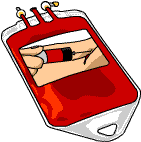Donating Blood in the USA
Created | Updated May 31, 2006

If you haven't donated blood because you're scared, this entry will help you face your fear and leap at the chance to take part in this worthwhile pursuit. If you haven't donated blood because you think it takes too much time, you might like to know you'll be in the door and out again in an hour.
The Procedure
Show up, tell the nice Red Cross people who you are, and you get a 'what you should know before donating blood' pamphlet to read. This will tell you about the very few risks involved, as well as all the various reasons why they might not want your blood 1.
Next, fill out your basic identification information2. You will also have to answer a number of yes-or-no questions, that will indicate whether you are a risky donor or not.
Then a nurse will review the form. They will also take your temperature, pulse, and blood pressure. They'll prick your finger or earlobe to draw just enough blood to run a haematocrit test, to find out if you are anaemic, for example. If you pass all the tests, and are considered to be a healthy individual, you'll get left alone with a piece of paper with two bar codes on it one of which translates as 'Use My Blood' and the other which translates as 'Don't Use My Blood', that means that if you're a risky donor and you want to donate anyhow, you don't put anyone else at risk and you can choose which one to use in private. Take this seriously.
Next you lie down and squeeze a rubberised grip a few times to make the veins stand out. The nurse will clean your arm with betadine, and then use a tourniquet or blood pressure cuff to make the veins stand out more before inserting the needle. It hurts, but not much. It's not as bad as a bee sting or a bad paper cut.
Sit there and chat while they take off a pint of blood. No big deal.
When the blood bag is full, the nurse will take out the needle and apply a bandage to the site.
Now you get your rewards: a little sticker that says 'I Donated Blood Today', some juice and donuts or cookies. This is to make sure that you take some time to recover, and the drink is to help replace the fluid you've lost while giving blood. Take advantage of them, as you will have earned them.
Platelet Pheresis
When most people think of donating blood they think of lying back for a few minutes and filling a pint sack with whole blood. There is, however, an alternative procedure called platelet pheresis, or sometimes just apheresis.
Blood consists of a lot of different components. In platelet pheresis, whole blood is drawn from one arm and sucked into a large machine. Inside the machine is a rapidly-spinning centrifuge, which uses an artificially-high gravitational field to separate the blood into its component parts. The part of interest, normally the platelets, is separated and stored in a bag inside the machine. The rest is returned to the donor, along with some sterile saline solution and anticoagulant, through a needle in the other arm.
Packed platelets are used in the treatment of some forms of leukaemia and anaemia. The matching of platelets to recipients is complex, varying according to tissue types as well as the more usual blood types. People whose platelets end up being a good match for someone in need might receive a lot of calls to come in and donate. If you're interested in becoming a donor, you can obtain more information by calling your local Red Cross.
The result is that instead of donating whole blood you donate a bag of packed platelets. Platelets also regenerate quickly, meaning that you can do this once a week or more often.

